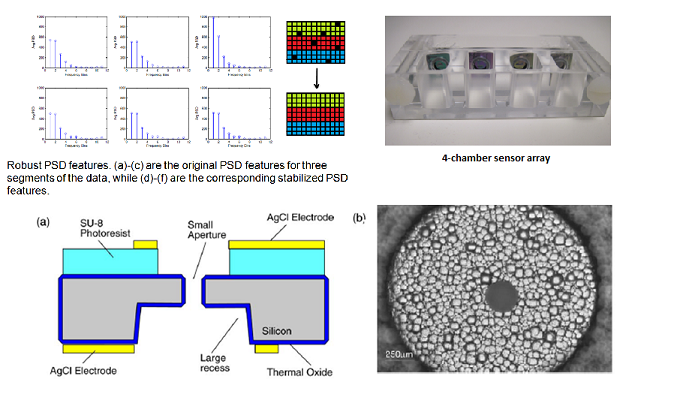 |
|
|
| |
Recent Results of Ion-Channel Research
and J-DSP Dissemination Efforts
(NSF EXP-SA Award No. 0730810)
PI: Prof. Andreas Spanias
Co PI: Dr. Stephen Goodnick
|
|
| |
Ion-channel sensors which mimic naturally occurring pore-forming proteins can be used to detect small metal ions and organic molecules. A chamber with a lipid bilayer hosting ion-channels produced by protein insertion constitutes such a sensor. Each analyte produces a characteristic signal pattern during its migration from one section of the chamber to another through the ion-channels. A four chamber ion-channel sensor array is built for accurate analyte detection. We have developed spectral and low rank models for representing ion-channel signals and proposed a analyte detection framework using sensor array.
|
| |
|
| |
Key Points |
| |
|
| |
 Transform domain features feature were proposed to characterize ion-channel signals.
Transform domain features feature were proposed to characterize ion-channel signals.
|
| |
 Robust PSD features obtained with low rank assumption lead to higher classification rates.
Robust PSD features obtained with low rank assumption lead to higher classification rates.
|
| |
 PSD features were also used to estimate number of channels.
PSD features were also used to estimate number of channels.
|
| |
 Decision level fusion of ion-channel sensor array produced lower false hit rates.
Decision level fusion of ion-channel sensor array produced lower false hit rates.

(Top left) Robust PSD features for ion-channel signals obtained using matrix completion.
(Bottom left) Cross-section through the ion channel support chip showing the etched hole through the oxidized silicon substrate.
(Bottom right) Optical micrograph of the engineered aperture.
(Top right) Four Si chips with 30 Ám apertures mounted vertically in an acrylic fixture with individual front baths and common rear bath.
|
| |
Presentation |
| |
|
| |
 Ion-Channel Research Summary
Ion-Channel Research Summary
|
| |
|
| |
J-DSP Dissemination Efforts |
| |
|
| |
 Link
Link
|
| |
|
| |
Relevent Publications: |
| |
|
| |
Journal Publications: |
| |
|
|
[1] K. N. Ramamurthy, J. J. Thiagarajan, P. Sattigeri, M. Goryll, A. Spanias, T. Thornton, S.Phillips, "Transform domain features for ion-channel signal classification", Biomedical Signal Processing and Control, 6(3), 219-224, 2010. Elsevier Ltd. |
|
| |
|
| |
Conference Proceedings: |
| |
|
| |
[2] B. Konnanath, P. Sattigeri, T. Mathew, A. Spanias, S. Prasad, M. Goryll, T. Thornton and P. Knee, "Acquiring and Classifying Signals from Nanopores and Ion-Channels ", in 19th International Conference on Artificial Neural Networks (ICANN 2009), Limassol, September 2009.
|
|
| |
|
| |
[3] K. N. Ramamurthy, J. J. Thiagarajan, P. Sattigeri, B. Konnanath, A. Spanias, T. Thornton, S. Prasad, M. Goryll, S.Phillips and S. Goodnick, "Transform Domain Features for Ion-Channel Signal Classification using Support Vector Machines ", in 9th International Conference on Information Technology and Applications in Biomedicine, (ITAB-09'), Larnaca, November 2009.
|
|
| |
|
| |
[4] P. Sattigeri, J. J. Thiagarajan, K. N. Ramamurthy, B. Konnanath, T. Mathew, A. Spanias, M. Goryll, T. Thornton, S. Prasad, S. Phillips, "Signal processing for biologically inspired sensors ", 4th International Symposium on Communications, Control and Signal Processing (ISCCSP),
2010, vol., no., pp.1-5, March 2010.
|
|
| |
|
| |
[5] P. Sattigeri, J. J. Thiagarajan, K. N. Ramamurthy, P. Joshi, A. Spanias, M. Goryll and T. Thornton, "Analysis of Coulter counting data from nanopores using clustering ", in
Sensor Signal Processing for Defence (SSPD), London, UK, September 2010.
|
|
| |
|
| |
[6] P. Sattigeri, J. J. Thiagarajan, K. N. Ramamurthy,
P. Joshi, A. Spanias, M. Goryll and T. Thornton, “Analyte
detection using an ion-channel sensor array,” in 16th
International conference on Digital Signal Processing (DSP2011),
Corfu, Greece, July 2011. |
|
| |
|
| |
[7] P. Sattigeri, J. J. Thiagarajan, K. N. Ramamurthy, A. Spanias, M. Goryll and T. Thornton, "Robust
PSD features for ion-channel signals ", in
Sensor Signal Processing for Defence (SSPD), London, UK, September 2011.
|
|
|
|
|
|
| |
|
|
| |
|
|
| |
|
|
| |
|
|
|
|

